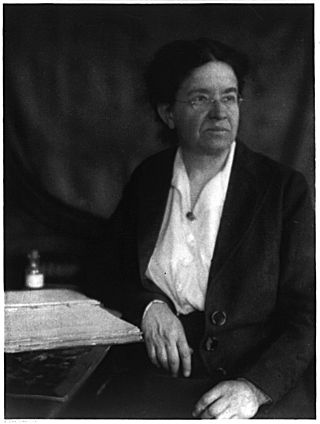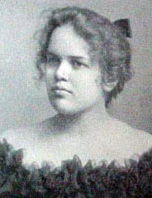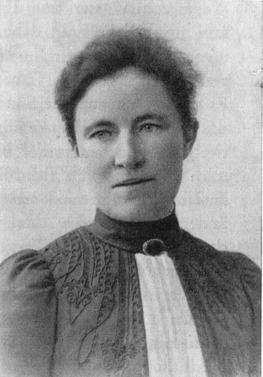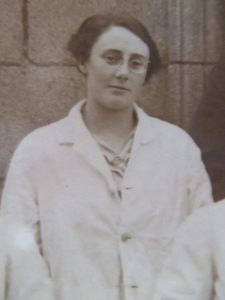
Florence Rena Sabin was an American medical scientist. She was a pioneer for women in science; she was the first woman to hold a full professorship at Johns Hopkins School of Medicine, the first woman elected to the National Academy of Sciences, and the first woman to head a department at the Rockefeller Institute for Medical Research. During her years of retirement, she pursued a second career as a public health activist in Colorado, and in 1951 received the Albert Lasker Public Service Award for this work.

Elizabeth Helen Blackburn, is an Australian-American Nobel laureate who is the former president of the Salk Institute for Biological Studies. In 1984, Blackburn co-discovered telomerase, the enzyme that replenishes the telomere, with Carol W. Greider. For this work, she was awarded the 2009 Nobel Prize in Physiology or Medicine, sharing it with Carol W. Greider and Jack W. Szostak, becoming the first Australian woman Nobel laureate.

Adelaide Crapsey was an American poet. She was born in Brooklyn, New York, and raised in Rochester, New York. Her parents were the businesswoman Adelaide T. Crapsey and the Episcopal priest Algernon Sidney Crapsey, who moved from New York City to Rochester.

Florence Barbara Seibert was an American biochemist. She is best known for identifying the active agent in the antigen tuberculin as a protein, and subsequently for isolating a pure form of tuberculin, purified protein derivative (PPD), enabling the development and use of a reliable TB test. Seibert has been inducted into the Florida Women's Hall of Fame and the National Women's Hall of Fame.

Marie-Louise Lachapelle was a French midwife, head of obstetrics at the Hôtel-Dieu, the oldest hospital in Paris. She published textbooks about women's bodies, gynecology, and obstetrics. She argued against forceps deliveries and wrote Pratique des accouchements, long a standard obstetric text, which promoted natural deliveries. Lachapelle is generally regarded as the mother of modern obstetrics.

Anandibai Gopalrao Joshi was the first Indian female doctor of western medicine. She was the first woman from the erstwhile Bombay presidency of India to study and graduate with a two-year degree in western medicine in the United States. She was also referred to as Anandibai Joshi and Anandi Gopal Joshi.

Agnes McLaren FRCPI was a respected Scottish doctor who was one of the first to give medical assistance to women in India who, because of custom, were unable to access medical help from male doctors. Agnes was active in social justice causes including protests against the white slave trade. She signed the 1866 women's suffrage petition and was secretary of the Edinburgh National Society for Women's Suffrage alongside her stepmother, Priscilla Bright McLaren. In 1873 she travelled with Priscilla and Jane Taylour to give suffrage lectures in Orkney and Shetland. Her father had supported the campaign of first women who sought to study medicine at University of Edinburgh and Agnes became friends with Sophia Jex-Blake, one of the Edinburgh Seven. Her father did not however, support Agnes' own ambitions in this area. And as she could not graduate in medicine in Scotland, she went to study in France and later, in order to be permitted to practice at home, became a member of the Royal College of Dublin.
Lydia Maria DeWitt was an American pathologist and anatomist.
Martha Wollstein was an American physician. Wollstein was born in New York to a German Jewish family.

Marcella Boveri was an American biologist. She was married to the German biologist Theodor Boveri (1862–1915). Their daughter Margret Boveri (1900–1975) became one of the best-known post-war German journalists.

Dorothy Stopford Price was an Irish physician who was key to the elimination of childhood tuberculosis in Ireland by introducing the BCG vaccine.

Sara Elizabeth Branham Matthews (1888–1962) was an American microbiologist and physician best known for her research into the isolation and treatment of Neisseria meningitidis, a causative organism of meningitis.
Linda Bartels Lange was an American bacteriologist known for her study of cancer, tuberculosis, and infectious diseases.
Toni von Langsdorff was a German obstetrician/gynecologist known for her work as an early woman doctor and for her role as a pioneer member of the Medical Women's International Association.
The Evening Dispensary for Working Women and Girls was an innovative American health care service at the turn of the twentieth century. As a public dispensary, it provided "outpatient medical treatment and advice to patients, in contrast to the inpatient service provided by hospitals". It offered medical treatment for poor women, educated the public on health matters, and provided female medical students with an opportunity to learn and gain experience.
Elma Sandford-Morgan was an Australian physician who practised medicine in India and Iraq during the 1920s.
Soledad Florendo was a Filipino physician who spent most of her career fighting tuberculosis.

Love Rosa Hirschmann Gantt, was an American physician based in South Carolina.

Caroline Cunningham Bedell Thomas was an American cardiologist. She is considered a pioneer in the study of hypertension and preventive medicine. In 1970, Thomas became the Johns Hopkins School of Medicine third female full professor.
Helen L. Smits was a health policy influencer and advocate in the United States, and lent her voice to several healthcare initiatives abroad. Most notably, she was a recipient of the Fulbright scholarship and served under the Carter and Clinton administrations. She also held positions in government organizations including the National Institutes of Health (NIH) and Healthcare Financing Administration.











